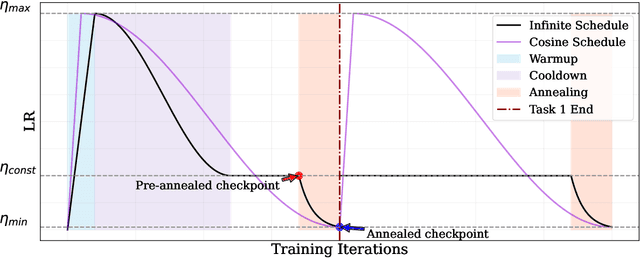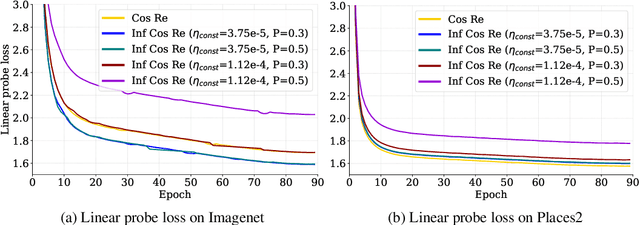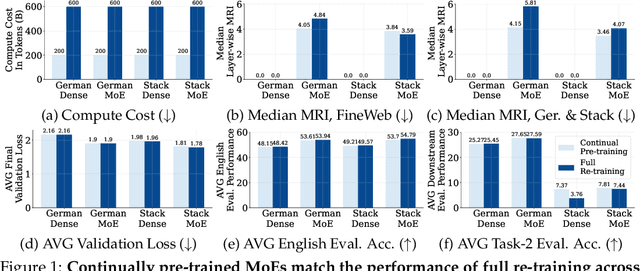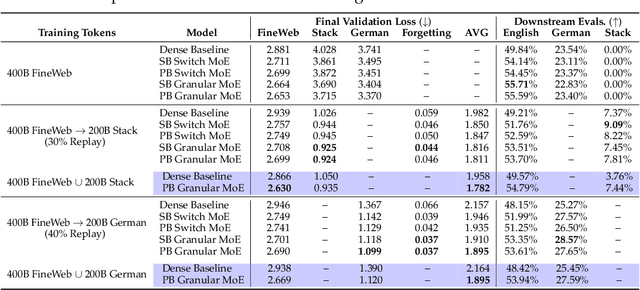Eugene Belilovsky
MILA
When Data Falls Short: Grokking Below the Critical Threshold
Nov 06, 2025Abstract:In this paper, we investigate the phenomenon of grokking, where models exhibit delayed generalization following overfitting on training data. We focus on data-scarce regimes where the number of training samples falls below the critical threshold, making grokking unobservable, and on practical scenarios involving distribution shift. We first show that Knowledge Distillation (KD) from a model that has already grokked on a distribution (p1) can induce and accelerate grokking on a different distribution (p2), even when the available data lies below the critical threshold. This highlights the value of KD for deployed models that must adapt to new distributions under limited data. We then study training on the joint distribution (p1, p2) and demonstrate that while standard supervised training fails when either distribution has insufficient data, distilling from models grokked on the individual distributions enables generalization. Finally, we examine a continual pretraining setup, where a grokked model transitions from p1 to p2, and find that KD both accelerates generalization and mitigates catastrophic forgetting, achieving strong performance even with only 10% of the data. Together, our results provide new insights into the mechanics of grokking under knowledge transfer and underscore the central role of KD in enabling generalization in low-data and evolving distribution settings.
Warming Up for Zeroth-Order Federated Pre-Training with Low Resource Clients
Sep 03, 2025Abstract:Federated learning enables collaborative model training across numerous edge devices without requiring participants to share data; however, memory and communication constraints on these edge devices may preclude their participation in training. We consider a setting in which a subset of edge devices are below a critical memory or communication threshold required to conduct model updates. Under typical federated optimization algorithms, these devices are excluded from training which renders their data inaccessible and increases system induced bias. We are inspired by MeZO, a zeroth-order method used for memory-efficient fine-tuning. The increased variance inherent to zeroth-order gradient approximations has relegated previous zeroth-order optimizers exclusively to the domain of fine tuning; a limitation we seek to correct. We devise a federated, memory-efficient zeroth-order optimizer, ZOWarmUp that permits zeroth-order training from a random initialization. ZOWarmUp leverages differing client capabilities and careful variance reduction techniques to facilitate participation of under-represented, low-resource clients in model training. Like other federated zeroth-order methods, ZOWarmUp eliminates the need for edge devices to transmit their full gradients to the server and instead relies on only a small set of random seeds, rendering the up-link communication cost negligible. We present experiments using various datasets and model architectures to show that ZOWarmUp is a robust algorithm that can can be applied under a wide variety of circumstances. For systems with a high proportion of edge devices that would otherwise be excluded from training, this algorithm provides access to a greater volume and diversity of data, thus improving training outcomes.
Less is More: Undertraining Experts Improves Model Upcycling
Jun 17, 2025Abstract:Modern deep learning is increasingly characterized by the use of open-weight foundation models that can be fine-tuned on specialized datasets. This has led to a proliferation of expert models and adapters, often shared via platforms like HuggingFace and AdapterHub. To leverage these resources, numerous model upcycling methods have emerged, enabling the reuse of fine-tuned models in multi-task systems. A natural pipeline has thus formed to harness the benefits of transfer learning and amortize sunk training costs: models are pre-trained on general data, fine-tuned on specific tasks, and then upcycled into more general-purpose systems. A prevailing assumption is that improvements at one stage of this pipeline propagate downstream, leading to gains at subsequent steps. In this work, we challenge that assumption by examining how expert fine-tuning affects model upcycling. We show that long fine-tuning of experts that optimizes for their individual performance leads to degraded merging performance, both for fully fine-tuned and LoRA-adapted models, and to worse downstream results when LoRA adapters are upcycled into MoE layers. We trace this degradation to the memorization of a small set of difficult examples that dominate late fine-tuning steps and are subsequently forgotten during merging. Finally, we demonstrate that a task-dependent aggressive early stopping strategy can significantly improve upcycling performance.
PyLO: Towards Accessible Learned Optimizers in PyTorch
Jun 12, 2025Abstract:Learned optimizers have been an active research topic over the past decade, with increasing progress toward practical, general-purpose optimizers that can serve as drop-in replacements for widely used methods like Adam. However, recent advances -- such as VeLO, which was meta-trained for 4000 TPU-months -- remain largely inaccessible to the broader community, in part due to their reliance on JAX and the absence of user-friendly packages for applying the optimizers after meta-training. To address this gap, we introduce PyLO, a PyTorch-based library that brings learned optimizers to the broader machine learning community through familiar, widely adopted workflows. Unlike prior work focused on synthetic or convex tasks, our emphasis is on applying learned optimization to real-world large-scale pre-training tasks. Our release includes a CUDA-accelerated version of the small_fc_lopt learned optimizer architecture from (Metz et al., 2022a), delivering substantial speedups -- from 39.36 to 205.59 samples/sec throughput for training ViT B/16 with batch size 32. PyLO also allows us to easily combine learned optimizers with existing optimization tools such as learning rate schedules and weight decay. When doing so, we find that learned optimizers can substantially benefit. Our code is available at https://github.com/Belilovsky-Lab/pylo
MuLoCo: Muon is a practical inner optimizer for DiLoCo
May 29, 2025Abstract:DiLoCo is a powerful framework for training large language models (LLMs) under networking constraints with advantages for increasing parallelism and accelerator utilization in data center settings. Despite significantly reducing communication frequency, however, DiLoCo's communication steps still involve all-reducing a complete copy of the model's parameters. While existing works have explored ways to reduce communication in DiLoCo, the role of error feedback accumulators and the effect of the inner-optimizer on compressibility remain under-explored. In this work, we investigate the effectiveness of standard compression methods including Top-k sparsification and quantization for reducing the communication overhead of DiLoCo when paired with two local optimizers (AdamW and Muon). Our experiments pre-training decoder-only transformer language models (LMs) reveal that leveraging Muon as the inner optimizer for DiLoCo along with an error-feedback accumulator allows to aggressively compress the communicated delta to 2-bits with next to no performance degradation. Crucially, MuLoCo (Muon inner optimizer DiLoCo) significantly outperforms DiLoCo while communicating 8X less and having identical memory complexity.
Incentivizing Permissionless Distributed Learning of LLMs
May 27, 2025Abstract:We describe an incentive system for distributed deep learning of foundational models where peers are rewarded for contributions. The incentive system, \textit{Gauntlet}, has been deployed on the bittensor blockchain and used to train a 1.2B LLM with completely permissionless contributions of pseudo-gradients: no control over the users that can register or their hardware. \textit{Gauntlet} can be applied to any synchronous distributed training scheme that relies on aggregating updates or pseudo-gradients. We rely on a two-stage mechanism for fast filtering of peer uptime, reliability, and synchronization, combined with the core component that estimates the loss before and after individual pseudo-gradient contributions. We utilized an OpenSkill rating system to track competitiveness of pseudo-gradient scores across time. Finally, we introduce a novel mechanism to ensure peers on the network perform unique computations. Our live 1.2B run, which has paid out real-valued tokens to participants based on the value of their contributions, yielded a competitive (on a per-iteration basis) 1.2B model that demonstrates the utility of our incentive system.
Beyond Cosine Decay: On the effectiveness of Infinite Learning Rate Schedule for Continual Pre-training
Mar 06, 2025



Abstract:The ever-growing availability of unlabeled data presents both opportunities and challenges for training artificial intelligence systems. While self-supervised learning (SSL) has emerged as a powerful paradigm for extracting meaningful representations from vast amounts of unlabeled data, existing methods still struggle to adapt to the non-stationary, non-IID nature of real-world data streams without forgetting previously learned knowledge. Recent works have adopted a repeated cosine annealing schedule for large-scale continual pre-training; however, these schedules (1) inherently cause forgetting during the re-warming phase and (2) have not been systematically compared to existing continual SSL methods. In this work, we systematically compare the widely used cosine schedule with the recently proposed infinite learning rate schedule and empirically find the latter to be a more effective alternative. Our extensive empirical evaluation across diverse image and language datasets demonstrates that the infinite learning rate schedule consistently enhances continual pre-training performance compared to a repeated cosine decay without being restricted to a fixed iteration budget. For instance, in a small-scale MAE pre-training setup, it outperforms several strong baselines from the literature. We then scale up our experiments to larger MAE pre-training and autoregressive language model pre-training. Our results show that the infinite learning rate schedule remains effective at scale, surpassing repeated cosine decay for both MAE pre-training and zero-shot LM benchmarks.
Continual Pre-training of MoEs: How robust is your router?
Mar 06, 2025



Abstract:Sparsely-activated Mixture of Experts (MoE) transformers are promising architectures for foundation models. Compared to dense transformers that require the same amount of floating point operations (FLOPs) per forward pass, MoEs benefit from improved sample efficiency at training time and achieve much stronger performance. Many closed-source and open-source frontier language models have thus adopted an MoE architecture. Naturally, practitioners will want to extend the capabilities of these models with large amounts of newly collected data without completely re-training them. Prior work has shown that a simple combination of replay and learning rate re-warming and re-decaying can enable the continual pre-training (CPT) of dense decoder-only transformers with minimal performance degradation compared to full re-training. In the case of decoder-only MoE transformers, however, it is unclear how the routing algorithm will impact continual pre-training performance: 1) do the MoE transformer's routers exacerbate forgetting relative to a dense model?; 2) do the routers maintain a balanced load on previous distributions after CPT?; 3) are the same strategies applied to dense models sufficient to continually pre-train MoE LLMs? In what follows, we conduct a large-scale (>2B parameter switch and DeepSeek MoE LLMs trained for 600B tokens) empirical study across four MoE transformers to answer these questions. Our results establish a surprising robustness to distribution shifts for both Sinkhorn-Balanced and Z-and-Aux-loss-balanced routing algorithms, even in MoEs continually pre-trained without replay. Moreover, we show that MoE LLMs maintain their sample efficiency (relative to a FLOP-matched dense model) during CPT and that they can match the performance of a fully re-trained MoE at a fraction of the cost.
FairDropout: Using Example-Tied Dropout to Enhance Generalization of Minority Groups
Feb 10, 2025



Abstract:Deep learning models frequently exploit spurious features in training data to achieve low training error, often resulting in poor generalization when faced with shifted testing distributions. To address this issue, various methods from imbalanced learning, representation learning, and classifier recalibration have been proposed to enhance the robustness of deep neural networks against spurious correlations. In this paper, we observe that models trained with empirical risk minimization tend to generalize well for examples from the majority groups while memorizing instances from minority groups. Building on recent findings that show memorization can be localized to a limited number of neurons, we apply example-tied dropout as a method we term FairDropout, aimed at redirecting this memorization to specific neurons that we subsequently drop out during inference. We empirically evaluate FairDropout using the subpopulation benchmark suite encompassing vision, language, and healthcare tasks, demonstrating that it significantly reduces reliance on spurious correlations, and outperforms state-of-the-art methods.
Non-Uniform Parameter-Wise Model Merging
Dec 20, 2024Abstract:Combining multiple machine learning models has long been a technique for enhancing performance, particularly in distributed settings. Traditional approaches, such as model ensembles, work well, but are expensive in terms of memory and compute. Recently, methods based on averaging model parameters have achieved good results in some settings and have gained popularity. However, merging models initialized differently that do not share a part of their training trajectories can yield worse results than simply using the base models, even after aligning their neurons. In this paper, we introduce a novel approach, Non-uniform Parameter-wise Model Merging, or NP Merge, which merges models by learning the contribution of each parameter to the final model using gradient-based optimization. We empirically demonstrate the effectiveness of our method for merging models of various architectures in multiple settings, outperforming past methods. We also extend NP Merge to handle the merging of multiple models, showcasing its scalability and robustness.
 Add to Chrome
Add to Chrome Add to Firefox
Add to Firefox Add to Edge
Add to Edge